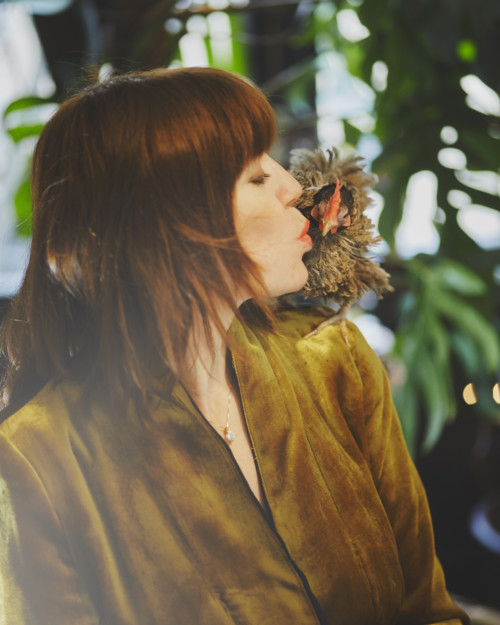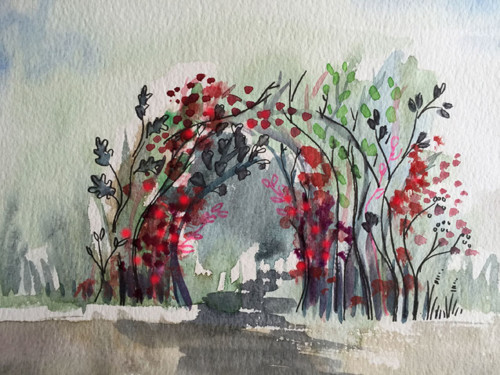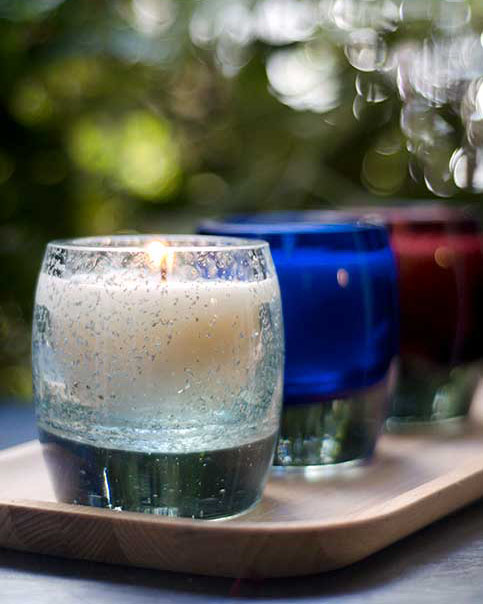Stepping Into The Magical World of Marianne Guedin, Plant Scenographer
In the bohemian Parisian quarter of Montmartre, Marianne Guedin, a plant scenographer and set designer highly sought after by big luxury brands, welcomes us into her workshop which brims with all kinds of flowers. She is in the middle of putting them in water so that they open before a client event. As she does so, her little hen wanders freely around the apartment.
GC: Introduce us to your adorable hen!
MG: She is called Poulette, and she’s from my village, Saint-Julien, next to Dijon. There’s a man there who collects unusual birds. She’s a Curly Silkie. I also have a Brittany Spaniel. And I even used to have budgies flying around.
GC: What has your career path been like so far? Did you dream about this job as a child?
MG: No. When I was little, I wanted to be a sculpter, but now I wouldn’t change this job for the world. For me, there have been three main stages where I’ve made progress. I had a very happy childhood with eccentric parents, quite an eccentric mother and an education which gave me confidence in myself. Then I trained as a set designer at Les Arts Décoratifs in Paris, which gave me an artistic education. At the same time, I sold flowers on Rue Custine. Then I spent a few years at a big florist. These opportunities have led me to this role. I’ve always worked in parallel with flowers and design.
GC: Why do people say your set designs are grandiose?
MG: Because they often involve hugely-long displays. I once did flowers for Valentino in Rome with a table 750 m long. It was pretty enormous. And for the Monumenta exhibition at the Grand Palais, I provided flowers for a banquet with a table about 35 m long. And then for a Cartier Fine Jewelry installation at Versailles, I did seven tables that were all 35 m long. My installations can also be about pure stage design. I did the decor for the haute couture catwalk show for Israeli brand Galia Lahav at the Grand Palais. There were no flowers, but huge totem poles instead.










GC: Which of your designs would you say is the most representative of your work?
MG: I love it when I’m asked to do table decor for Valentino parties because they only want strange flowers– like black ones– and I love anything strange! It’s an eccentric, nonconsensual world. We do some real team work around themes that really makes us think. Last time there was a Gothic theme. We mixed foliage from different French regions with exotic flowers and it ended up looking just like a painting. I always use fruits and flowers, as if they were dabs of paint.
GC: What does a typical Marianne Guedin composition look like?
MG: My compositions are like paintings with baroque staging. I mix plants with fruits and sweets, and weeds with sophisticated flowers, as if you were coming back from a woodland walk and someone had added the local florist’s treasures to the scene. I also love [using] bunches of red currants, which I weave with sewing thread so they look big…
GC: What are your artistic influences?
MG: My art studies and Modern Art. Even if you can’t see it in my baroque compositions, these are the things that encourage and inspire me. Collages by Matisse, Calder mobiles, a little world created with next to nothing… As for the baroque, I get that from 18th century Italian painting, and I love vanitas paintings: skulls, hourglasses, and wilted flowers.
“The first time I was asked to do three days of decor for a prince’s marriage in the south of France. Huge quantities of flowers had to be transported… Really, nothing could go wrong.”
GC: Your father was a magician. Did he inspire this taste for set design in you?
MG: For sure! He took us to see shows, invited us to the circus… He did “close-up” living room magic. He wasn’t sawing women in two, but rather doing little card tricks to divert the attention, although there was still an air of the spectacular created with next to nothing.
GC: What place has inspired you most?
MG: My mother’s garden when I was little. There were no restrictions and nothing was forbidden. She mixed up colors and varieties [of plants] and it was so pretty.
GC: What has been your biggest challenge?
MG: The first time I was asked to do three days of decor for a prince’s marriage in the south of France. There were three themes. The first night was fuchsia and rose, the second was white with dashes of blue, and then there was a big pastel brunch with meadow flowers. Huge quantities of flowers had to be transported. Really, nothing could go wrong.
GC: Do you have any insider tips?
MG: I call it the “Colette trick”. My friend Colette taught me a technique for attaching flowers to moss to make tall compositions and transport them easily. She changed my life with that so I’d really like you to keep this bit of the interview in!
GC: Your perfumed candles have been a big success. How are they made?
MG: I tell my stories to a professional nose: my childhood memories, times I have travelled, food smells… For example, my “Dingue de Guedin” candle smells like it did in my childhood when I crossed my parents’ garden and then went into the neighbor’s orchard to reach the bus stop, whose bus would take me to school in Dijon. It smells like wet ground, fresh grass, and orchard flowers.
GC: You’re always flirting with design because you also create objects. How did that begin?
MG: At the start, I created objects which would serve the flowers in some way. I was Creator of the Year for Now! at the MAISON & OBJET trade show because of my vase collection. And little by little I developed my knowledge. Then I brought out my candles. I also make objets d’art and, now, a standard lamp for a high-end furniture brand, as well.
GC: Final question: What is your favorite aspect of this job/passion you have?
MG: When people say “thank you very much”, because I always doubt everything right up until the final moment. My greatest pleasure is when I feel people are happy and I see them smiling. I didn’t expect to be doing this job, you know, but I’d like to tell those beginning their journeys that when you love what you do, you always reach your goals. Anything is possible!
















































